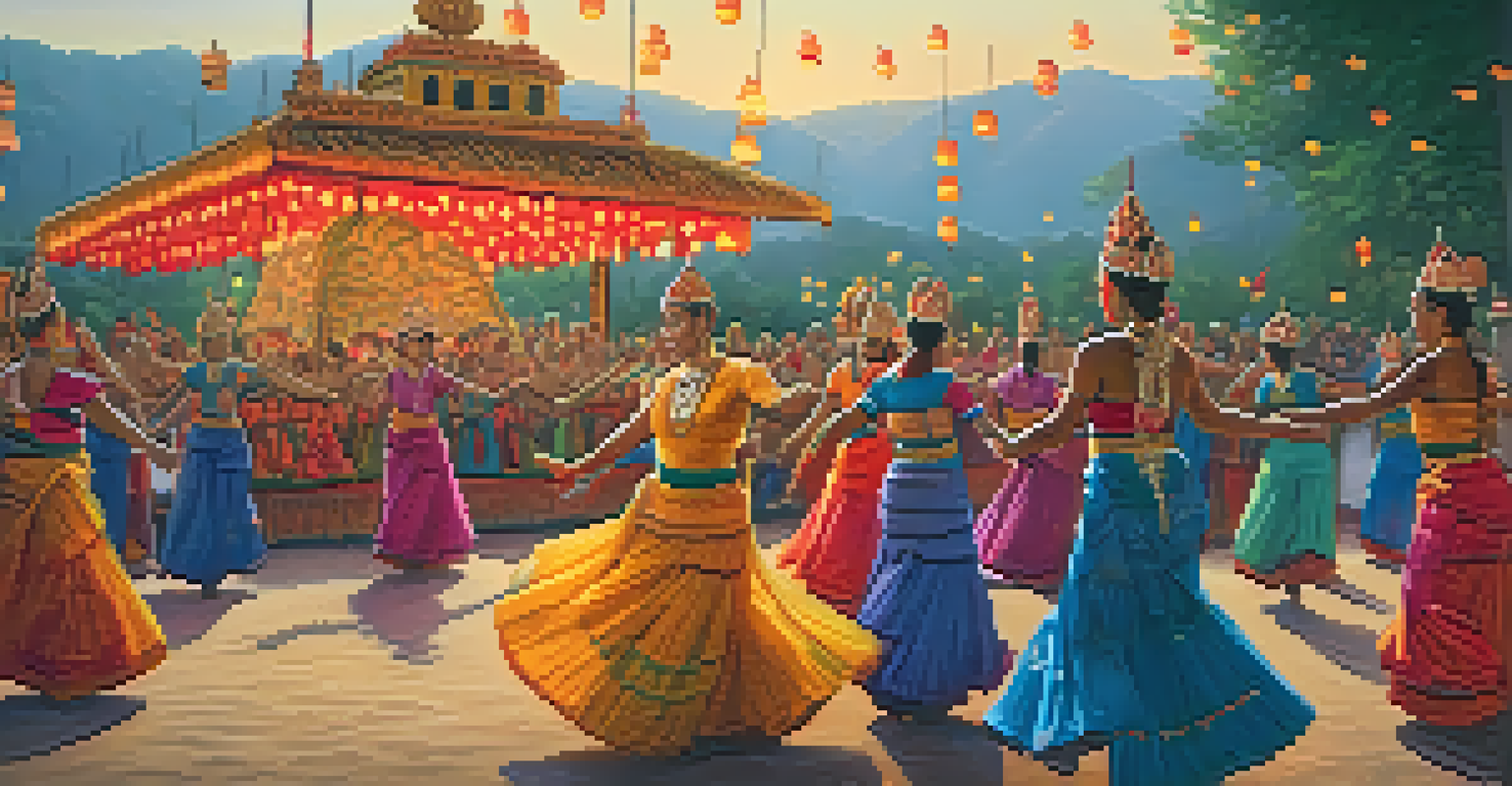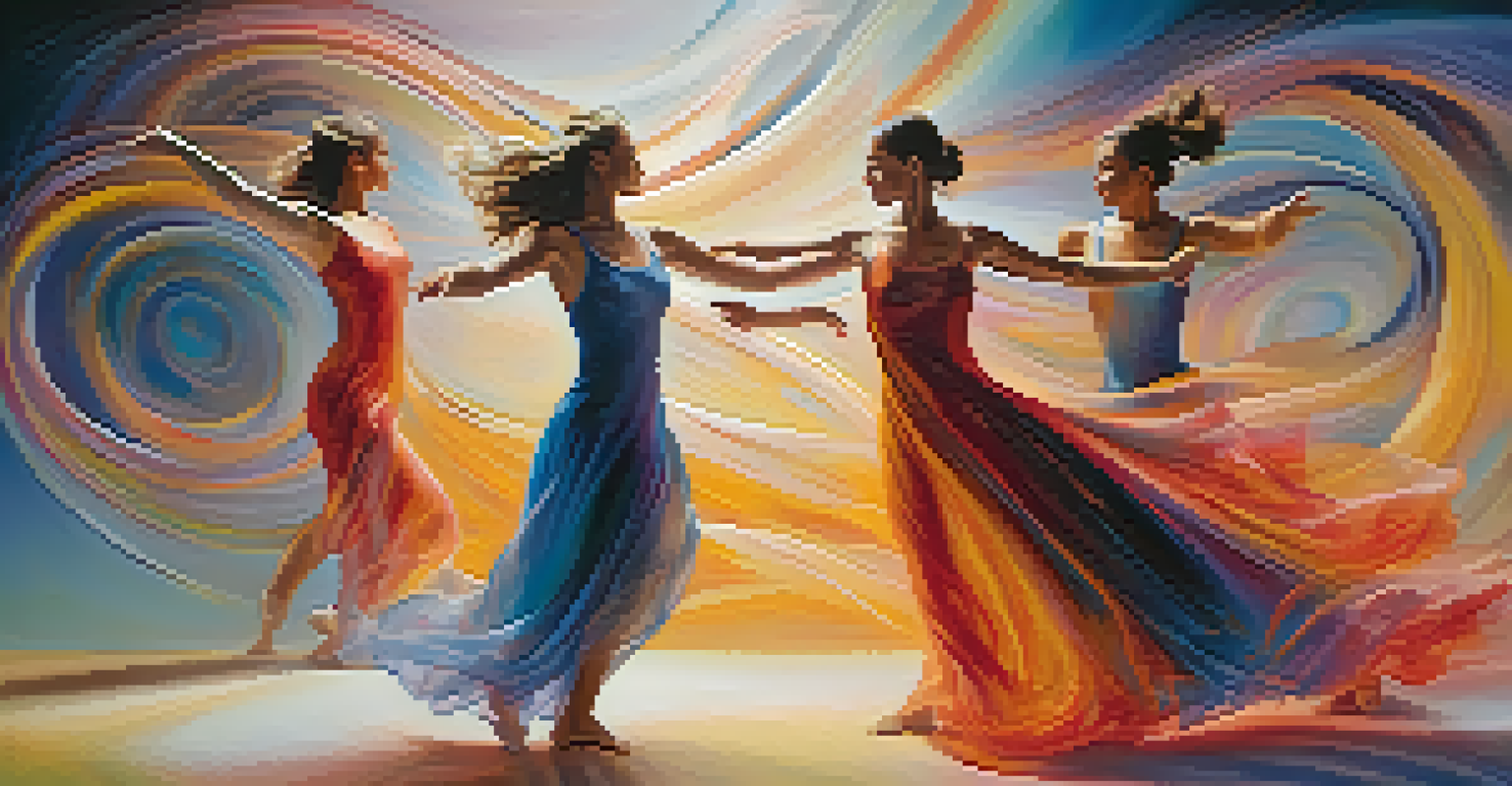Dance and the Human Experience in Postmodern Literature

The Interplay of Dance and Literature in Postmodernism
In postmodern literature, dance serves as a powerful metaphor for the complexities of human experience. Authors often use dance to illustrate the fluidity of identity and the interconnectivity of relationships. Just as dance combines rhythm, movement, and emotion, literature weaves together narrative, character, and theme, creating a rich tapestry of meaning.
Dance is the hidden language of the soul.
For instance, in works like 'The Ice Cream Man' by David Foster Wallace, dance is not merely a physical act but a representation of the chaotic human condition. The characters' movements reflect their internal struggles, mirroring the disjointed nature of postmodern narratives. This connection enhances the reader's understanding of the characters' emotional landscapes.
Ultimately, the integration of dance into literature invites readers to explore deeper themes of existence, challenging them to consider how movement and expression shape our understanding of life.
Dance as a Form of Resistance in Postmodern Texts
Postmodern literature often embraces dance as a form of resistance against societal norms and conventions. Through dance, characters express their individuality and challenge oppressive structures, highlighting the tension between conformity and freedom. This theme resonates strongly in works like 'Beloved' by Toni Morrison, where dance becomes a symbol of liberation.

In 'Beloved', the act of dancing is intertwined with the characters' memories of trauma and survival. It represents a reclamation of identity, as the characters physically embody their histories while moving toward healing. This powerful imagery reinforces the idea that dance can transcend language, conveying emotions that words may fail to express.
Dance as Identity and Expression
Dance in postmodern literature serves as a powerful metaphor for exploring identity and personal expression.
Thus, dance emerges not just as an art form, but as a vital act of defiance, demonstrating the resilience of the human spirit amidst adversity.
Embodiment and Identity in Dance-Infused Narratives
The concept of embodiment is central to the exploration of identity in postmodern literature, and dance often plays a critical role in this theme. Through physical movement, characters articulate their struggles with self-identity and the societal expectations placed upon them. Dance, in this context, becomes a vehicle for self-discovery and personal expression.
Literature is a dance of words, capturing the rhythm of life.
For example, in 'The Brief Wondrous Life of Oscar Wao' by Junot Díaz, dance is depicted as a means of connecting with cultural heritage and personal history. The characters' movements reflect their attempts to navigate their identities within a complex social landscape. This dynamic interplay between body and identity illustrates how dance can serve as a powerful narrative tool.
Ultimately, the embodiment of dance in literature invites readers to consider the intricate relationship between physicality and identity, emphasizing that our movements can reveal profound truths about who we are.
The Role of Dance in Exploring Emotion and Connection
Dance has an intrinsic capability to convey emotions that transcend language, making it a compelling element in postmodern literature. Authors often use dance to explore the nuances of human connection, revealing the depths of longing, joy, and sorrow. This emotional resonance invites readers to engage with the text on a visceral level.
In novels like 'The Unbearable Lightness of Being' by Milan Kundera, dance symbolizes the intricate dance of relationships, showcasing the interplay between intimacy and distance. The characters’ movements reflect their emotional states, creating a layered understanding of their connections. This use of dance brings a physicality to the emotional landscape of the narrative.
Resistance Through Movement
Characters use dance as a form of resistance against societal norms, highlighting themes of liberation and individuality.
Thus, through dance, literature captures the essence of human relationships, illustrating how movement can encapsulate the complexities of love and loss.
Cultural Significance of Dance in Postmodern Literature
Dance also serves as a reflection of cultural identity in postmodern literature, highlighting the diverse experiences of various communities. Authors often incorporate traditional dance forms to explore themes of heritage, belonging, and cultural expression. This integration allows for a richer understanding of the characters' lives and the societal contexts they inhabit.
For example, in 'The Joy Luck Club' by Amy Tan, traditional Chinese dances are woven into the narrative, symbolizing the characters' ties to their cultural roots. These moments of dance evoke a sense of nostalgia and connection, bridging generations and experiences. The cultural significance of dance thus becomes a powerful tool for storytelling.
Through the lens of dance, literature not only celebrates cultural diversity but also critiques the complexities of cultural assimilation and identity.
Dance as a Reflection of Time and Space in Literature
In postmodern literature, the concept of time and space is often fluid, and dance embodies this fluidity beautifully. The rhythm and movement of dance can transcend linear storytelling, allowing characters to experience time in a non-traditional manner. This quality creates a unique narrative structure that mirrors the chaotic essence of postmodernism.
For instance, in 'Slaughterhouse-Five' by Kurt Vonnegut, the protagonist's experience of time is fragmented, much like the movements in a dance. The disjointed nature of his journey reflects the unpredictability of life and the interconnectedness of past, present, and future. Dance, therefore, becomes a metaphor for this temporal exploration.
Cultural Reflections in Dance
Incorporating dance into narratives emphasizes cultural identity and heritage, enriching the characters' connections to their backgrounds.
By employing dance as a narrative device, authors effectively challenge conventional notions of time and space, inviting readers to engage with the text in new and innovative ways.
The Impact of Dance on Reader Engagement and Interpretation
The incorporation of dance into postmodern literature significantly impacts reader engagement and interpretation. Dance evokes a sensory experience, drawing readers into the narrative and encouraging them to visualize the movements and emotions being portrayed. This immersive quality fosters a deeper connection to the characters and their journeys.
As readers encounter dance within a narrative, they are prompted to reflect on their own experiences with movement and emotion. This personal engagement allows for diverse interpretations, as each reader brings their unique perspective to the text. Consequently, dance enriches the reading experience, prompting introspection and empathy.

In essence, the interplay of dance and literature creates a dynamic dialogue that enhances the overall impact of the narrative, inviting readers to explore not just the text, but their own humanity.
Conclusion: The Enduring Essence of Dance in Postmodern Literature
In conclusion, dance serves as a multifaceted element within postmodern literature, encapsulating the complexities of the human experience. Through its various representations, dance illuminates themes of identity, resistance, emotion, and cultural significance. This rich interplay between dance and narrative invites readers to reflect on their own experiences and perceptions.
As we delve into the world of postmodern literature, we discover that dance is more than just a physical expression; it is a profound commentary on the human condition. The characters' movements resonate with our own struggles and triumphs, reminding us of the interconnectedness of our experiences.
Ultimately, the enduring essence of dance in literature underscores its power to transcend boundaries, bridging art and life while celebrating the richness of the human experience.